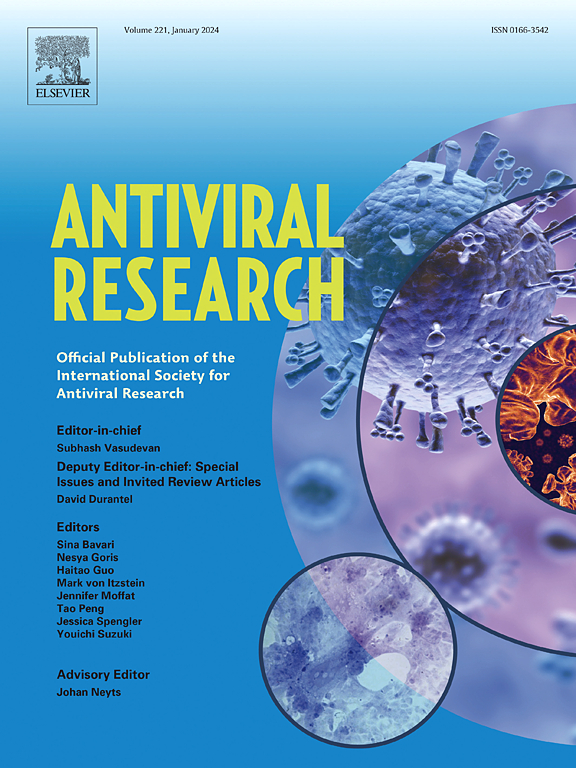Broad-spectrum antiviral ferruginol analog affects the viral proteins translation and actin remodeling during dengue virus infection
IF 4
2区 医学
Q1 PHARMACOLOGY & PHARMACY
引用次数: 0
Abstract
Dengue virus infection is the most important arbovirosis around the world. To date, no antiviral drugs have been approved for its treatment. Host-targeted antivirals (HTA) have emerged as a promising strategy, because of their high barrier to resistance. Using plaque-forming unit assays, molecular docking, fluorescence microscopy, image analysis, and molecular/cellular assays, it was found that 18-(phthalimide-2-yl)-ferruginol, a semi-synthetic analog of the bioactive diterpenoid ferruginol, couples with high affinity to RhoA GTPase. In addition, this molecule dramatically reduced actin filament formation and induced cellular morphological changes, when added to cell cultures before or after infection, without effect on microtubules or intermediate filaments. RhoA activation in infected cells was affected when the compound was added after 6 h.p.i. Furthermore, this compound decreased dengue virus-2 (DENV-2) E protein, NS3 protein, and dsRNA as measured by fluorescence microscopy, and changes in the distribution pattern of these viral components. 18-(phthalimide-2-yl)-ferruginol treatment at 6 and 12 h.p.i. reduces the virus yield. Western blot and RT-qPCR assays reveal that this analog decreased viral protein translation. Flow cytometry and wound-healing experiments also hint that cellular effects prompted for this compound do not relate to early apoptotic events and they could be reversible. Overall, our findings strongly suggest that 18-(phthalimide-2-yl)-ferruginol has an HTA mechanism, possibly disrupting the polyprotein translation of DENV-2 via alteration of RhoA-mediated actin remodeling and other related cellular and viral processes.

广谱抗病毒铁苷醇类似物在登革热病毒感染期间影响病毒蛋白翻译和肌动蛋白重塑
登革热病毒感染是世界上最重要的虫媒病毒病。到目前为止,还没有抗病毒药物被批准用于治疗这种疾病。宿主靶向抗病毒药物(HTA)已成为一种很有前途的策略,因为它们具有很高的耐药屏障。通过斑块形成单元分析、分子对接、荧光显微镜、图像分析和分子/细胞分析,发现18-(邻苯二胺-2-基)-铁二醇,一种生物活性二萜类铁二醇的半合成类似物,与RhoA GTPase具有高亲和力。此外,在感染前或感染后将该分子添加到细胞培养物中,可显著减少肌动蛋白丝的形成并诱导细胞形态变化,而对微管或中间丝没有影响。在6 hp后加入该化合物可影响感染细胞中RhoA的活化。此外,荧光显微镜检测该化合物可降低登革热病毒2 (DENV-2) E蛋白、NS3蛋白和dsRNA,并改变这些病毒成分的分布模式。18-(邻苯二酰亚胺-2-基)-铁二醇在6和12 hp时处理可降低病毒产量。Western blot和RT-qPCR分析显示,这种类似物减少了病毒蛋白的翻译。流式细胞术和伤口愈合实验也提示,这种化合物引起的细胞效应与早期凋亡事件无关,它们可能是可逆的。总之,我们的研究结果强烈表明,18-(邻苯二胺-2-酰基)-铁二醇具有HTA机制,可能通过改变rhoa介导的肌动蛋白重塑和其他相关的细胞和病毒过程来破坏DENV-2的多蛋白翻译。
本文章由计算机程序翻译,如有差异,请以英文原文为准。
求助全文
约1分钟内获得全文
求助全文
来源期刊

Antiviral research
医学-病毒学
CiteScore
17.10
自引率
3.90%
发文量
157
审稿时长
34 days
期刊介绍:
Antiviral Research is a journal that focuses on various aspects of controlling viral infections in both humans and animals. It is a platform for publishing research reports, short communications, review articles, and commentaries. The journal covers a wide range of topics including antiviral drugs, antibodies, and host-response modifiers. These topics encompass their synthesis, in vitro and in vivo testing, as well as mechanisms of action. Additionally, the journal also publishes studies on the development of new or improved vaccines against viral infections in humans. It delves into assessing the safety of drugs and vaccines, tracking the evolution of drug or vaccine-resistant viruses, and developing effective countermeasures. Another area of interest includes the identification and validation of new drug targets. The journal further explores laboratory animal models of viral diseases, investigates the pathogenesis of viral diseases, and examines the mechanisms by which viruses avoid host immune responses.
 求助内容:
求助内容: 应助结果提醒方式:
应助结果提醒方式:


